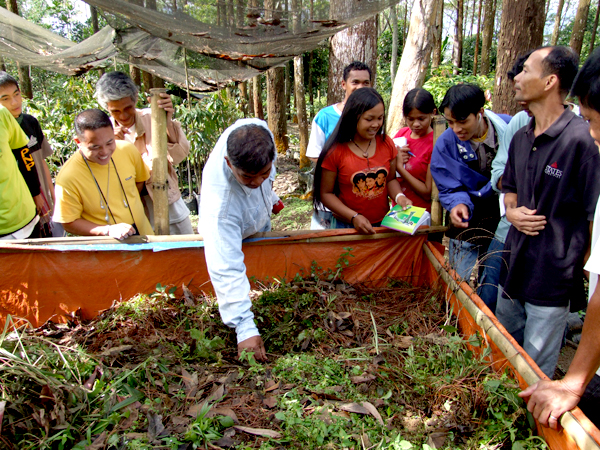
SPECIAL REPORT/ Second of 3 parts
MALAYBALAY CITY (MindaNews/12 July) – Until the 1980s, the country’s natural resource protection regime had relied heavily on law enforcement. Forest protection in particular made use of forest rangers as the front line of defense against illegal logging and violations done by holders of Timber License Agreements. The ranger system proved to be a failure though, leaving the forests to the tender mercies of loggers many of whom were also politicians.
Realizing the loopholes in conservation laws, a number of environment groups lobbied for the enactment of a protected area law to conserve the country’s remaining rainforests, rich marine reserves and other ecologically important sites. In June 1992, President Corazon C. Aquino signed into law the National Integrated Protected Areas System Act (Republic Act 7586). But unlike the western models of the law which strictly prohibit human habitation inside protected areas the Philippine version does not seek to evict local communities. The law, however, qualifies that only indigenous communities and migrants who have lived in a protected area since 1987 or earlier may opt to stay.
RA 7586 grants these communities the right to remain in their places of abode with a clear purpose in mind: to mobilize these communities as a “social fence” against illegal extraction of resources inside protected areas. At first glance, this privilege looks sufficient to motivate the people into helping the government achieve its conservation goals.
Yet as shown by experience, secure tenure alone is no guarantee of active community involvement. From 1992, when the NIPAS Act was passed, and until the latter part of that decade, timber poaching remained a pressing problem around the park. Based on the reports of the Protected Area Superintendent’s Office (PASu) and minutes of meetings of the Protected Area Management Board between 12 and 20 incidents were monitored each year. The highest number of incidents (26) occurred in 1998. PASu Felix Mirasol Jr. opined that since a severe El Nino hit the province that year many upland dwellers engaged in timber poaching in order to survive.
Investigations done by the PASu revealed that local people were involved in timber smuggling and that buyers were mainly based in Cagayan de Oro City. For sure, there were occupants who cooperated with the park management by reporting timber smuggling and other illegal activities. Most of them (were) members of the Kitanglad Guard Volunteers, community members who conduct forest patrols and report violations to the PASu. Aside from uniforms, they receive meager honoraria and are deputized by the regional office of the DENR.
But while the work done by the KGVs may have lessened violations of park rules some of them had to pay a price. For instance, Leonardo Bonye, then a councilor of Imbayao, a buffer zone village in Malaybalay City lost in his reelection bid because he naturally lost the support of families that depended [on timber smuggling]. Digging deeper, it now appeared that enlisting community support had engendered divisions and conflicts.
The park management was aware that survival was the chief cause why park occupants had resorted to illegal resource extraction and that law enforcement and community organizing alone would not completely stop this practice. Starting in 1997, and with KIN as the chief facilitator, the PAMB approved a livelihood program for buffer zone residents through grants from the GEF in a bid to stop their dependence on forest resources.
 For the park management, the economic incentive was a purely pragmatic measure to roll back forest degradation, a typical carrot and stick policy. But KIN director Easterluna Canoy, an anthropologist, opted to view it as an ethical issue. “Isn’t it unfair to tell the occupants to sacrifice without giving them anything – even just crumbs – in return?” she asked, adding, “The project is not only about forests and wildlife. It’s also about people. It’s not only about preserving ecosystems. It’s also about caring for people who should benefit from it.”
For the park management, the economic incentive was a purely pragmatic measure to roll back forest degradation, a typical carrot and stick policy. But KIN director Easterluna Canoy, an anthropologist, opted to view it as an ethical issue. “Isn’t it unfair to tell the occupants to sacrifice without giving them anything – even just crumbs – in return?” she asked, adding, “The project is not only about forests and wildlife. It’s also about people. It’s not only about preserving ecosystems. It’s also about caring for people who should benefit from it.”
But regardless of how one views the livelihood program, the facilitator itself, KIN, noted some major flaws. KIN noted two glaring defects. First, the program, conceived by Manila-based consultants, failed to consider the people’s technical capability and culture. Second, it failed to realize that “livelihood projects alone are not a sufficient response to the problem of rural impoverishment especially in a setting like Mt. Kitanglad where grinding poverty manifests itself in the people’s critical dependence on forest resources”. KIN said that in addition to capital for livelihood projects, assistance in the form of social services, support infrastructure and literacy programs should be rendered.
A browse through the livelihood guidelines revealed that the consultants had in mind community organizations with a track record in managing socio-economic projects. Moreover, the guidelines imposed the following requisites for those that wished to avail of loans: credit worthiness, prospect of return of investments, savings mobilization experiences, and organizational and financial management capacities. “They (consultants) ignored the fact that the project deals with subsistence level communities,” Canoy said.
Nonetheless, Mt. Kitanglad pushed through with livelihood projects and chose not to be confined to the limitations set by the guidelines. By end-2001, the communities had obtained a total of P25 million in grants. Since there were 80 groups that availed of the grants each of them received an average of P312,500, although the actual amount could be higher or lesser depending on the individual project. A few availed of low-interest loans, but MindaNews was unable to get an indicative figure.
KIN said that retail financing institutions like cooperatives, although allowed by the guidelines to participate in the livelihood scheme, shied away. They cited stringent Land Bank accreditation requirements, high interest rates, and doubts on the ability of the POs to succeed in their projects production and marketing wise are among the reasons cited. Land Bank was the depository bank of the livelihood funds coming from the GEF through the World Bank.
As expected, not all of the livelihood projects succeeded in the economic sense of the word. But some have managed to prosper. One of these is in barangay Dahilayan, Manolo Fortich town where the KGVs have a thriving cattle-raising project. It was this group of volunteers that reported, in 2008, the cutting of natural grown trees for a planned resort of a Cagayan de Oro-based capitalist in an area near the buffer zone. Another KGV group in barangay Kaatoan, Lantapan continues to cultivate productive coffee and abaca farms using organic inputs.
In barangay Imbayao, Malaybalay City, more farmers have been convinced to shift to environment-friendly agricultural practices such as contour farming and agroforestry, which as the name implies, is a combination of agriculture and forestry.
The actual economic benefits that have accrued to the park occupants from the livelihood projects are debatable at this point. Yet based on the emerging practice of adopting natural farming systems by a growing number of park occupants the real argument may no longer be just economic but also social in nature. As Dr. Caroline Ongleo, a professor at the University of the Philippines in Los Banos and KIN’s monitoring and evaluation consultant, noted in a paper written in 2003: “…Natural, physical and financial capitals are generally insignificant to contribute to sustainability of livelihoods. However, human and social capitals, particularly the type and degree of participation enhanced the potential for sustainability of the livelihoods.”
Canoy, for her part, stressing the significance of people’s participation, posed a point to ponder on: “What’s a few thousand pesos compared to the intrinsic value of a forest preserved or a denuded area restored through community efforts?”
(Next: Reemerging species)
